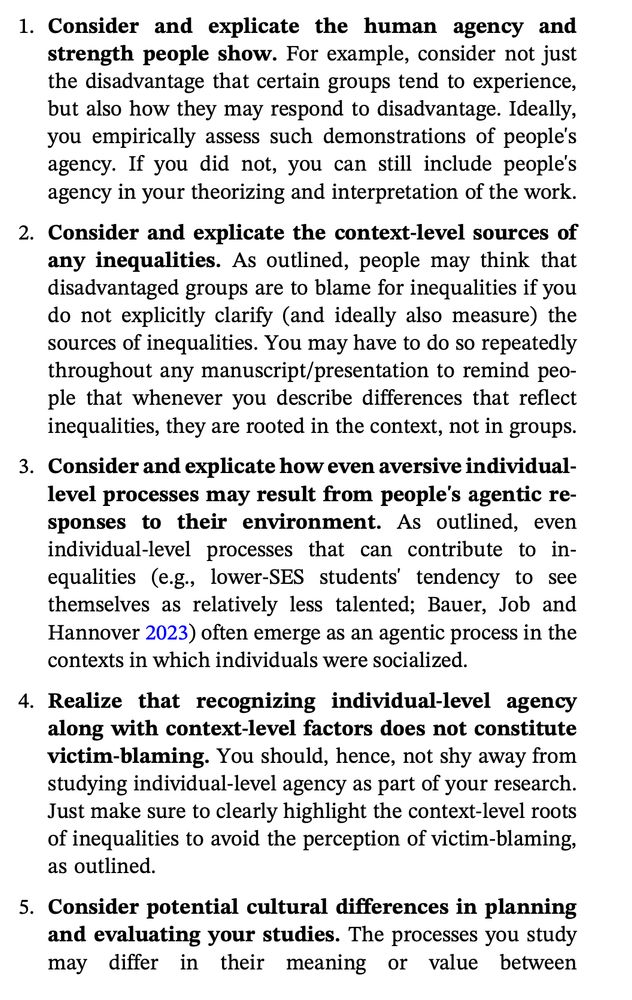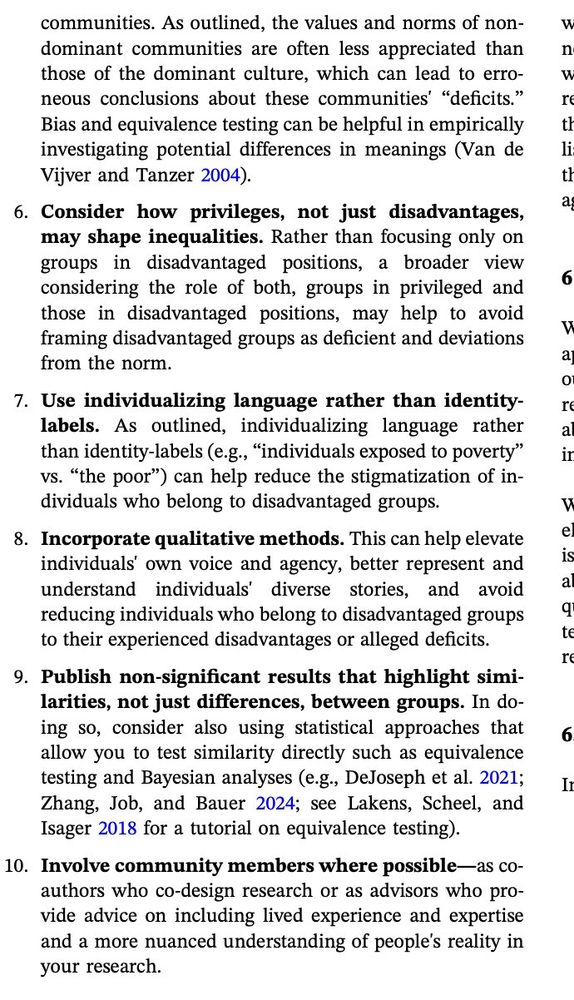
Christina Bauer
@cabauer.bsky.social
Social & educational psych. Aiming to reduce barriers to stigmatized individuals’ goal pursuit and wellbeing. UVienna.
https://www.christina-anna-bauer.com/research
https://www.christina-anna-bauer.com/research
In doing so, we hope our review can inform the different lines of research investigating beliefs about difficulties from different angles, and help us better understand difficulty beliefs as a larger phenomenon.
June 26, 2025 at 12:13 PM
In doing so, we hope our review can inform the different lines of research investigating beliefs about difficulties from different angles, and help us better understand difficulty beliefs as a larger phenomenon.
We propose a unifying mechanistic model and show how an integrative perspective can clarify how difficulty beliefs shape motivation, coping, and long-term outcomes across contexts.
June 26, 2025 at 12:13 PM
We propose a unifying mechanistic model and show how an integrative perspective can clarify how difficulty beliefs shape motivation, coping, and long-term outcomes across contexts.
We show that across these various types of difficulties investigated, a similar pattern emerges: People commonly focus on the negative effects of difficulties, and embracing a more nuanced view of difficulties can support important life outcomes.
June 26, 2025 at 12:13 PM
We show that across these various types of difficulties investigated, a similar pattern emerges: People commonly focus on the negative effects of difficulties, and embracing a more nuanced view of difficulties can support important life outcomes.
While willpower-theory research focuses on a task-level difficulties (e.g., a math task), stress mindset theory focuses on a life-situation level (e.g., stress at work), and identity-reframing on identity-level challenges (e.g., difficulties connected to lower SES backgrounds)
June 26, 2025 at 12:13 PM
While willpower-theory research focuses on a task-level difficulties (e.g., a math task), stress mindset theory focuses on a life-situation level (e.g., stress at work), and identity-reframing on identity-level challenges (e.g., difficulties connected to lower SES backgrounds)
Prior work has examined beliefs about the effects of difficulties in so far disconnected lines of research, focusing on different types of difficulties, and partly using different terminologies, methods and outcome-foci.
June 26, 2025 at 12:13 PM
Prior work has examined beliefs about the effects of difficulties in so far disconnected lines of research, focusing on different types of difficulties, and partly using different terminologies, methods and outcome-foci.
It was great fun writing this article and creating this model together with @andreicimpian.bsky.social, @aashnap.bsky.social, and Eddie Brummelman - really happy and grateful we did this! :)
May 26, 2025 at 2:12 PM
It was great fun writing this article and creating this model together with @andreicimpian.bsky.social, @aashnap.bsky.social, and Eddie Brummelman - really happy and grateful we did this! :)
Overall, we hope this paper helps us better understand how and when brilliance-beliefs contribute to inequalities. I also hope it provides a useful ground for intervention work in this space, which I think is much needed.
May 26, 2025 at 2:12 PM
Overall, we hope this paper helps us better understand how and when brilliance-beliefs contribute to inequalities. I also hope it provides a useful ground for intervention work in this space, which I think is much needed.
The other-related path describes how important others in a given environment (e.g., teachers) can doubt students' belonging based on brilliance-beliefs, triggering disempowering treatments of students, which can cause further harm, undermining educational equality, too.
May 26, 2025 at 2:12 PM
The other-related path describes how important others in a given environment (e.g., teachers) can doubt students' belonging based on brilliance-beliefs, triggering disempowering treatments of students, which can cause further harm, undermining educational equality, too.
The self-related path concerns mechanisms that lie within the student; students may doubt their own belonging and they mal also anxiously wonder, whether others see them as belonging in a given environment; both can trigger anxiety and other mechanisms that can cause harm.
May 26, 2025 at 2:12 PM
The self-related path concerns mechanisms that lie within the student; students may doubt their own belonging and they mal also anxiously wonder, whether others see them as belonging in a given environment; both can trigger anxiety and other mechanisms that can cause harm.
Regarding processes, BBM distinguishes between two broad paths: the self- and other-related path.
May 26, 2025 at 2:12 PM
Regarding processes, BBM distinguishes between two broad paths: the self- and other-related path.
This interplay explains, why educational inequalities tend to be more pronounced in some fields (e.g., philosophy or physics - fields with stronger brilliance-beliefs) than others (e.g., education, or biology).
May 26, 2025 at 2:12 PM
This interplay explains, why educational inequalities tend to be more pronounced in some fields (e.g., philosophy or physics - fields with stronger brilliance-beliefs) than others (e.g., education, or biology).
If this is the case, this student is generally seen as belgonging less in the respective environment which then triggers down-stream mechanisms that ultimately drive inequalities.
May 26, 2025 at 2:12 PM
If this is the case, this student is generally seen as belgonging less in the respective environment which then triggers down-stream mechanisms that ultimately drive inequalities.
i) the student is in a brilliance-oriented environment (i.e., brilliance is thought to be important) and ii) the student is stereotyped as relatively less brilliant based on their social identity (being a woman, ethnic minority, or having a lower SES).
May 26, 2025 at 2:12 PM
i) the student is in a brilliance-oriented environment (i.e., brilliance is thought to be important) and ii) the student is stereotyped as relatively less brilliant based on their social identity (being a woman, ethnic minority, or having a lower SES).
BBM suggests that brilliance-beliefs work in concert with stereotypes; specifically, a student's outcomes are likely undermined, if 2 things coincide:
May 26, 2025 at 2:12 PM
BBM suggests that brilliance-beliefs work in concert with stereotypes; specifically, a student's outcomes are likely undermined, if 2 things coincide:
We hope this work is helpful in making progress toward a study of inequality that is as accurate and non-stigmatizing as possible. Thanks to my collaborators and the CERA network that made this all possible!
February 17, 2025 at 1:03 PM
We hope this work is helpful in making progress toward a study of inequality that is as accurate and non-stigmatizing as possible. Thanks to my collaborators and the CERA network that made this all possible!
In addition to outlining this approach, we distill it to 10 concrete research practices which we think are key . see here:

February 17, 2025 at 1:03 PM
In addition to outlining this approach, we distill it to 10 concrete research practices which we think are key . see here:
At the core of this holistic approach is a simultaneous recognition of context‐level disadvantage (a focus of traditional inequality research) and individual‐level agency (a focus of strength‐based research) in studying inequlity.
February 17, 2025 at 1:03 PM
At the core of this holistic approach is a simultaneous recognition of context‐level disadvantage (a focus of traditional inequality research) and individual‐level agency (a focus of strength‐based research) in studying inequlity.
In the present work, we hence set out to understand how we can conduct social inequality research that doesnt stigmatize, incorporating recent advances of strength-based research and traditional inequality research into what we call a "holistic" approach to studying inequality.
February 17, 2025 at 1:03 PM
In the present work, we hence set out to understand how we can conduct social inequality research that doesnt stigmatize, incorporating recent advances of strength-based research and traditional inequality research into what we call a "holistic" approach to studying inequality.
To counter such deficit-narratives, recent advances in strength-based research have tried to better understand and highlight the agency and strength people in disadvantaged positions often show. Yet, this research isn't sufficient to really understand how inequality works.
February 17, 2025 at 1:03 PM
To counter such deficit-narratives, recent advances in strength-based research have tried to better understand and highlight the agency and strength people in disadvantaged positions often show. Yet, this research isn't sufficient to really understand how inequality works.
here is the gist: In understanding the psychology of social inequalities, inequality research sometimes portrays people as weak (e.g., reducing them to the role of weak victims) or otherwise deficient, lacking in agency, motivation, and skills- all portrayals that can stigmatize.
February 17, 2025 at 1:03 PM
here is the gist: In understanding the psychology of social inequalities, inequality research sometimes portrays people as weak (e.g., reducing them to the role of weak victims) or otherwise deficient, lacking in agency, motivation, and skills- all portrayals that can stigmatize.


